Changes in General Health Status during Upper Cervical Chiropractic Care: A Practice-Based Research Project Update
Kathryn T. Hoiriis, BS, DCDeana Burd, BA
Research Department
Life University, School of Chiropractic
Marietta, GA
Edward F. Owens, Jr., MS, DC
Director of Research
Sherman College of Straight Chiropractic
Spartanburg, SC
ABSTRACT
Introduction: An upper cervical practice-based research (PBR) project, proposed at the 13th Annual Upper Cervical Conference in November 1996, is being used to study the effectiveness of upper cervical care related to the general health status of patients. This project uses the RAND (SF-36) Health Survey and a global well-being scale (GWBS) as primary outcome measures. Also, we are looking at concomitant changes in misalignment of the occipito-atlanto-axial joints as determined by pre- and post-adjustment radiographs.
Methods: Field doctors were recruited to contribute sequential information from their new patients between 18 and 59 years of age. The patients were followed through the course of care until maximum improvement for the presenting complaint was noted. The SF-36 was given to patients at the initial visit, after four weeks and at the end of the care plan (the level of maximal chiropractic improvement, MCI). The GWBS was completed at each visit. Radiographic analysis of upper cervical subluxation was recorded. Data are continually being collected from field practitioners and entered into a computerized database. This update summarizes the results from the first two years of the study.
Results: The patients (N=311) sought care for a variety of mostly musculoskeletal complaints: back pain (33.9%), neck pain (40.9%) and headache (9.8%). Forty % (N=34) of the 85 completed patients had acute complaints, while 60% (N=51) complained of chronic problems.
The average pre-adjustment C1 misalignment was 2.2 degrees of laterality. The average measured radiographic change was 51-75% with the average post-adjustment C1 misalignment reduced to 0.89 degrees.
The SF-36 data reduces to health scores ranging from 0 to 100 in eight discreet dimensions or subscales: physical function (PF), role physical (RP), bodily pain (BP), general health (GH), vitality (V), social function (SF), role emotional (RE) and mental health (MH). The mean SF-36 results for 4 week data (n=161) and MCI (n=85) show statistically significance changes from initial values (n=311) at both 4 weeks and MCI. All subscales showed improvement with the greatest average gain seen for role physical (39 points
Conclusions: In our chiropractic population, the improvement in average SF-36 scores might be attributed to changes in health due to the spinal correction, but there is no data available from a control population to support that conclusion.
This PBR project has succeeded in collecting initial data on more than 300 patients with complete follow-up data on less than half. Efforts are underway to further track the disposition of patients with incomplete records in the PBR database.
Key words: chiropractic, subluxation, practice-based research, upper cervical, RAND Health Survey, global well-being scale.
INTRODUCTION
A practice-based research network has been developed to collect general health data, patient demographics, and adjustment information on patients in chiropractic practices specializing in specific upper cervical care (1). In this study, the global well being scale and the RAND SF-36 are used as outcome measures. Over the past two years, upper cervical specific practitioners have obtained data from their patients without regard to type of complaints. Descriptions of the data collection methods and previous results have been presented elsewhere (1,2,3).
As previously reported, mean SF-36 scores of the chiropractic patients are well below the general population norms at the initiation of care. Improvement has been noted in all eight of the SF-36 subscales after four weeks of care, on the average, and further improvement has been noted at the time of maximal chiropractic improvement (MCI), where mean values in five of eight subscales exceed the normative values (2,3).
Data are continually being collected from field practitioners and entered into a computerized database. This updated report by researchers at Life University and Sherman College is based on statistical analysis of the combined data collected in the past two years. In addition to descriptive statistics on SF-36 changes, the database was queried to determine the chronicity of patientsí complaints, i.e., the range of time between the reported onset of chief complaint and the date of entrance into the practice. For patients with completed data, the gains made in SF-36 subscale scores were compared with the chronicity of the entering complaint.
Because complete SF-36 follow-up data are missing for many patients, data were analyzed to see if there were differences in complaint chronicity or entering SF-36 scores for patients who completed the study versus those who did not.
METHODS
Field doctors have been recruited to contribute information from their patients for this study. Patients between 18 and 59 years of age were recruited sequentially from the new patient population and were followed through the course of care until maximum improvement for the presenting complaint was noted. The SF-36 survey was administered at the outset of care, after four weeks of care, and at one final point when the doctor has determined that the patient has reached a level of maximal chiropractic improvement (MCI). The GWBS was administered at each visit and recorded along with the adjusted spinal segments on the patientsí visit records. Subluxation specific x-ray misalignment factors were collected for comparison to other outcome measures.
RESULTS
The results of the analysis on November 15, 1998, from 260 patients seeing 12 field doctors were compared to more recent analysis for 311 patients. The male/female ratio and the average age of the population have not changed with the addition of more patients. Female patients (60%) outnumber male patients (40%) in this population. The average age was 38 years. The age distribution is shown in Figure 1.

Entering Complaints: Care was sought for a variety of mostly musculoskeletal complaints. Back pain (33.9%), neck pain (40.9%) and headache (9.8%) were the most common complaints (Figure 2).
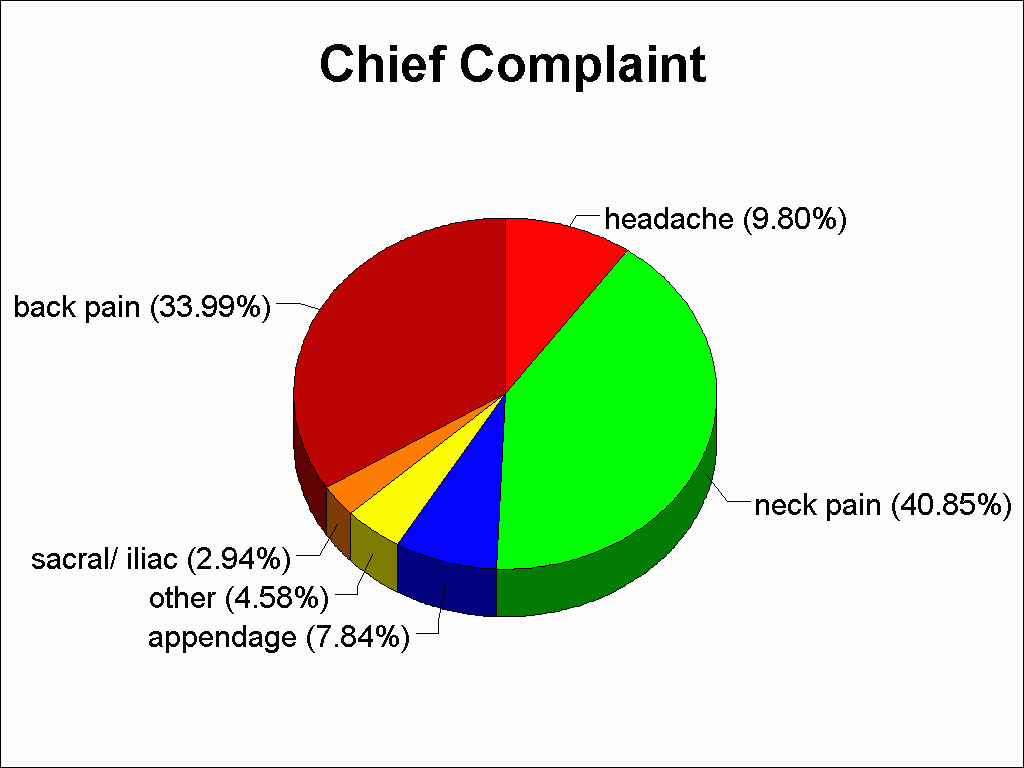
Chronicity of Complaints: Data on chronicity of complaints was available for 195 patients. Of these, 85 also had complete SF-36 data, while the remainder had not contributed their SF-36 questionnaire results at MCI. The chronicity of complaints was widely distributed between 0 days and more than 10 years. The distribution of duration of complaints for two groups of patients, those for whom complete data was available (N=85), and those patients for whom data was lacking (N=110) demonstrates similarities in chronicity for each group (Figure 3). In both groups, between 18% and 20% of the patients had duration of complaint of less than four weeks, while nearly 35% had duration of complaint greater than two years. By using a cutoff of eight weeks to designate patients as acute or chronic, we determined that 36% of patientsí complaints were acute in the group with complete data, whereas 42% of the patients with incomplete data had acute complaints.
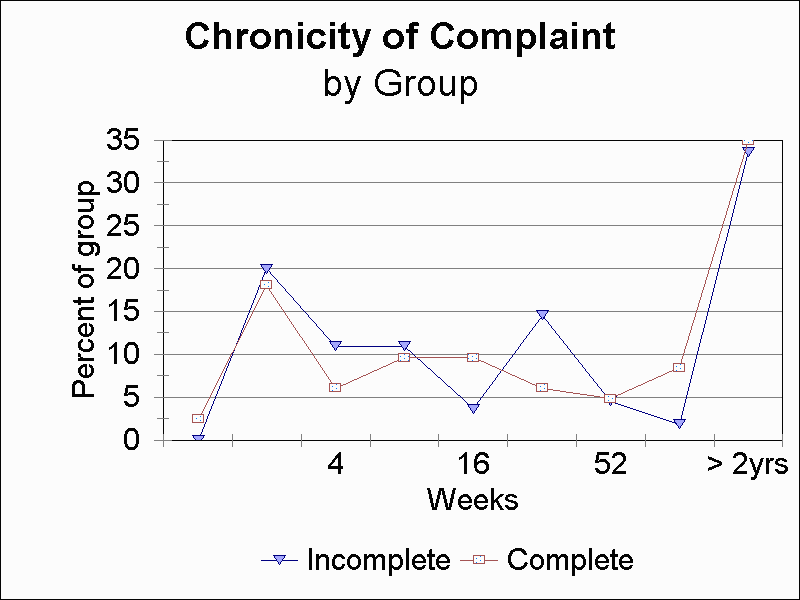
Initial SF-36 Scores: The initial SF-36 subscale profiles were plotted together for the patients with complete records, versus those without (Figure 4). The greatest difference is seen in the physical functioning (PF) scale for which the difference in the means (delta 5.8 points) was statistically significant (p< 0.05).
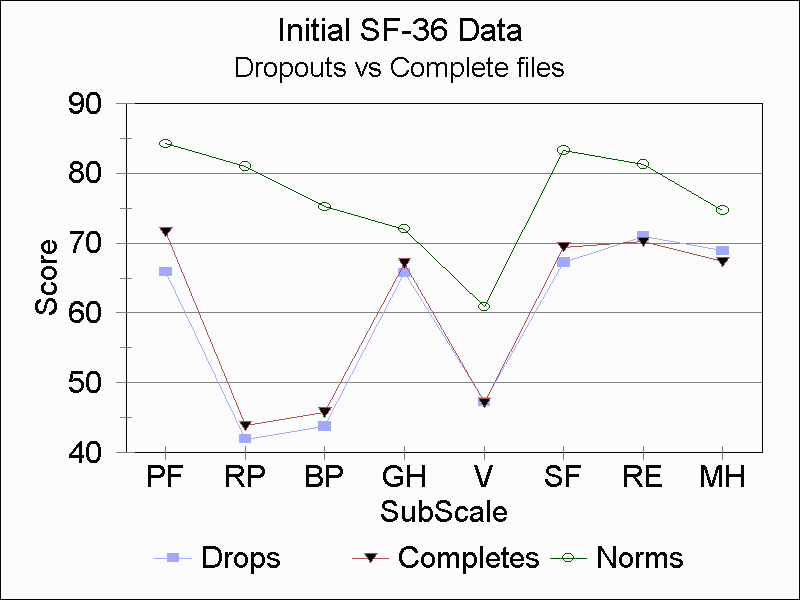
X-ray Listings: The average pre-adjustment C1 misalignment was 2.2 degrees. Atlas laterality was to the right in 57% and to the left in 44% of the patients. Atlas rotation was anterior 57%, neutral 4%, and posterior 39% of the time. The lower angle was to the right 39%, neutral 3%, and to the left 58%. The average measured radiographic change was 51%-75% (Figure 5), and the average post-adjustment C1 misalignment was reduced to 0.89 degrees.
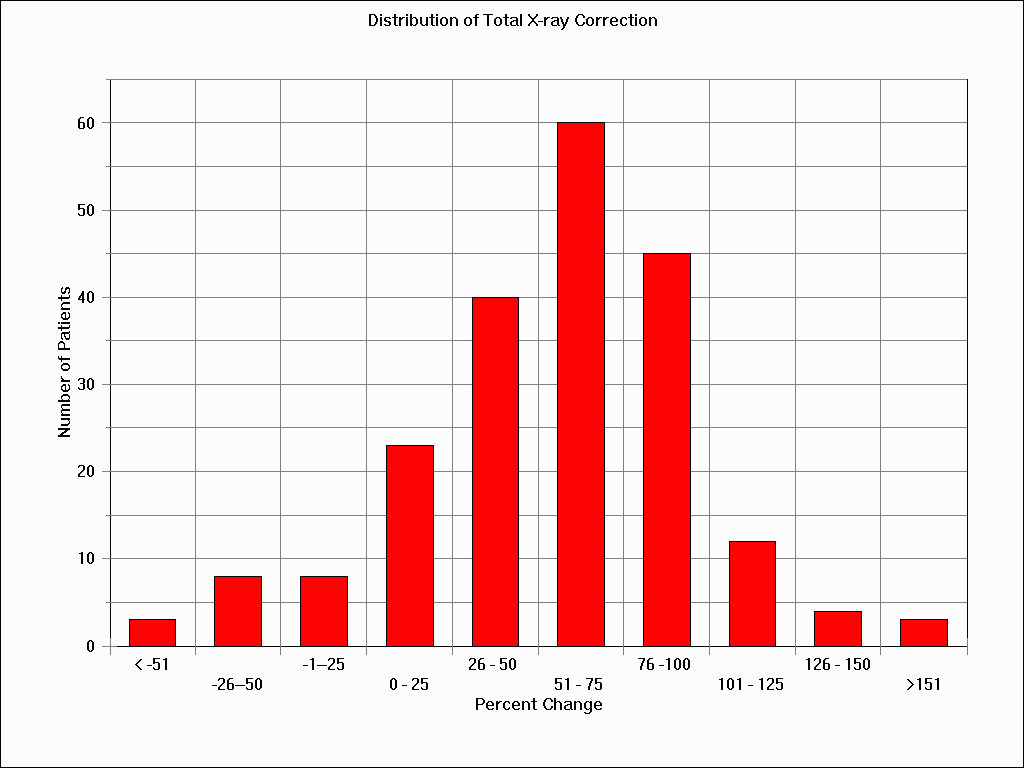
General Health Measures: The SF-36 data reduces to health scores ranging from 0 to 100 in eight discreet dimensions or subscales: physical function (PF), role physical (RP), bodily pain (BP), general health (GH), vitality (V), social function (SF), role emotional (RE) and mental health (MH). We had observed in previous analyses that initial SF-36 scores of the chiropractic patients were well below those for the general population norms (Figure 6). Patients reported scores demonstrated improvement in all subscales at four weeks, on the average, and further improvement at MCI, where mean values in five of the eight subscales exceed the mean values reported for the normal population. Statistical comparison of our MCI data to population norms is difficult due to the fact that these norms are not reported as means and standard deviations, but rather as percentiles. Statistical comparison might not be appropriate, anyway, since the normed population and our patient pool differ in demographic characteristics.
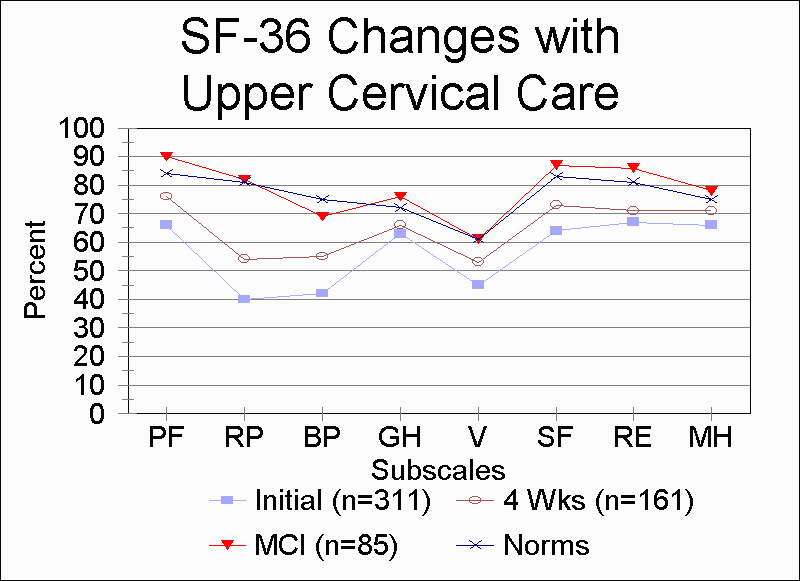
Table 1 shows the mean SF-36 results for initial (n=311), four-week data (n=161) and MCI (n=85). Studentís t-test (one-tailed, paired) was used to compare the initial to four-week and MCI scores for the subset of patients with complete data files (N=85). To correct for the multiple application of the t-test, the alpha level was adjusted to 0.01. At this alpha level, six of eight of the SF-36 subscales show statistically significance changes from initial to four-week values, and all scales were significantly improved at MCI.
Table 1. Mean values for SF-36 Subscales as Compared to Population Norms.
|
Subscale |
Initial (n=311) |
4-Wks (n=161) |
MCI (n=85) |
Population Norms |
|
Physical Functioning (PF) |
66 (24.3) |
76 (26.1)* |
88 (17.7)* |
84.2 |
|
Role Physical (RP) |
40 (40.9) |
54 (43.3)* |
78 (38.1)* |
81.0 |
|
Bodily Pain (BP) |
42 (20.7) |
55 (22.0)* |
69 (18.5)* |
75.2 |
|
General Health (GH) |
63 (21.6) |
66 (21.2) |
78 (17.3)* |
72.0 |
|
Vitality (V) |
45 (21.0) |
53 (19.3)* |
62 (19.7)* |
60.9 |
|
Social Functioning (SF) |
64 (26.4) |
73 (25.0)* |
86 (16.3)* |
83.3 |
|
Role Emotional (RE) |
67 (44.1) |
71 (40.2) |
84 (30.9)* |
81.3 |
|
Mental Health (MH) |
66 (20.0) |
71 (17.8)* |
78 (15.7)* |
74.7 |
Values are Means (SD)
*significant difference for n = 85 subset, as compared to initial values p < 0.01
Chronicity to SF-36 Comparisons: Initial and final SF-36 subscale data were compared with Studentís t-test for patients with completed data files (N=85). This group was further subdivided by chronicity of entering complaint into an acute (N=34) and a chronic (N=51) group. The initial data from the SF-36 profile for both groups (Initial Acute and Initial Chronic) are very similar, and no statistically significant differences were found at an alpha level of 0.05 (Figure 7). The final data (MCI Acute and MCI Chronic) followed similar trends, however, a statistically significant difference between the groups was found only in the social function subscale (p = 0.044).
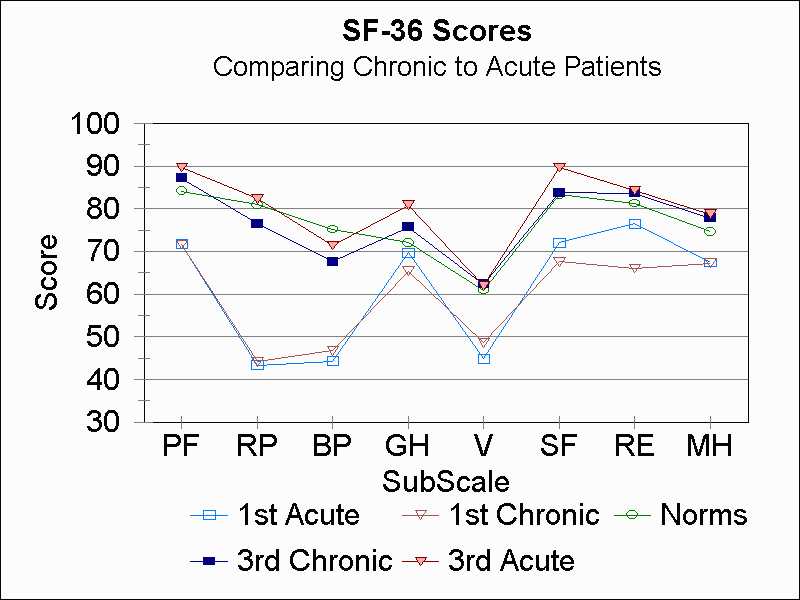
Gains in general health are represented in this graph and in Table 2. The greatest average gain, 39 points, was seen in the role physical subscale, although all scales showed improvement. The gains made by acute patients were not statistically different than those of chronic patients.
Table 2. Initial and Final SF-36 Scores for Acute and Chronic Complaint Groups
|
Initial SF-36 |
Final SF-36 |
Points Gained |
||||||||||
|
Acute |
Chronic |
Acute |
Chronic |
Acute |
Chronic |
|||||||
|
n |
34 |
51 |
34 |
51 |
34 |
51 |
||||||
|
Average Days |
16 |
1541 |
16 |
1541 |
16 |
1541 |
||||||
|
PF |
72 (23) |
72 (25) |
90 (17) |
87 (18) |
18 (23) |
16 (18) |
||||||
|
RP |
43 (39) |
44 (39) |
82 (32) |
76 (42) |
39 (47) |
32 (47) |
||||||
|
BP |
44 (20) |
47 (20) |
71 (20) |
68 (68) |
27 (25) |
21 (21) |
||||||
|
GH |
70 (20) |
65 (22) |
81 (14) |
76 (19) |
11 (16) |
10 (18) |
||||||
|
V |
45 (17) |
49 (20) |
62 (19) |
62 (20) |
17 (18) |
14 (25) |
||||||
|
SF |
72 (21) |
68 (24) |
90 (13) |
84 (18)* |
18 (22) |
16 (25) |
||||||
|
RE |
76 (34) |
66 (47) |
84 (34) |
84 (29) |
8 (38) |
18 (51) |
||||||
|
MH |
67 (16) |
67 (17) |
79 (16) |
78 (15) |
11 (15) |
11 (17) |
||||||
Values are Means(SD)
*significant difference as compared to initial values, p < 0.05
DISCUSSION
The SF-36 has been used in various forms of development since the late 1970s. The reliability has been found to be good (0.6-0.9) in both test-retest and split-half analyses in 14 different studies, although some scales are more reliable than others (4). Ware et al. (4) suggest using the SF-36 in studies where one treatment group is compared with another, and in single case studies with serial administration at intervals. They suggest that a 5 point change in a scale is a clinically significant change. In our chiropractic population we are seeing average changes ranging from 8 to 39 points.
Ware, et al., have also estimated the number of subjects needed to detect changes with 95% confidence. For a two group experimental study, around 400 subjects are needed, comparing post-intervention scores. Our original target size for this study, 400 (1), should produce a database suitable for comparison with other technique-specific data pools with 95% confidence that changes seen are statistically significant.
In contrast, comparing a group mean with a norm can be done with as few as 180 subjects (4). Even though there are only about 2,500 subjects in the pool used to develop those norms, great care was taken to balance age, sex, employment status, and location. There are differences in mean SF-36 scores based on location, particularly if the pool is rural versus urban. There are also age and sex differences, so that separate norms have been generated for each age or gender group. To date, our data collection efforts have not reached the target number of 400, although we have used the published norms of Ware, et al. (4), for comparison to our data. The data from Table 1 and Figure 6 show that initial scores are well below the norms, especially in the role physical (RP) and bodily pain (BP) subscales, where the point difference is 41 and 33, respectively, on a 100 point scale.
At MCI the scores have exceeded the national norms in five of the eight subscales. Physical functioning (PF) and general health (GH) show the greatest difference in the means, delta 3.8 and 6.0, respectively. The magnitude of these differences is on the order of the 5 points that Ware, et al., consider clinically significant. Interestingly, the bodily pain (BP) scores remain below the norm at MCI.
Although it is tempting to attribute the improvements in general health seen in chiropractic patients to the spinal adjustments provided, no data on a matching non-adjusted control group are available to support this conclusion. Other factors, such as the placebo effect or the natural course of the conditions under study, may have brought about these results. Based on Wareís review and analysis, test-retest error is probably not responsible for the magnitude of changes seen from initial to four-week and final scores.
In the current study, an investigation of the database was undertaken to determine the effects of chronicity of the patientsí conditions on the level of improvement seen under care. If chronicity and level of improvement are unrelated, it may allow the conclusion that some element of the care was responsible for improvements in general health, rather than maturation.
Data analysis has shown that the majority of patients entering the surveyed chiropractic practices have complaints of a chronic condition, lasting more than eight weeks. Furthermore, there is no relationship between gains made on SF-36 general health scores and the duration of complaint. Because acute as well as chronic health complaints show similar outcomes under this type of care, the data suggest that natural course of the condition is probably not responsible for the overall gains in health seen in this population.
A limitation in the applicability of the results of this practice based research study is the possibility that doctors might withhold information on their patients who do not respond well to care, contributing only data from patients with a desired outcome. This study was designed to overcome this limitation by having doctors submit initial data on successive series of new patients as soon as those patients entered the practice. Thus, a cross-section of the practice should be included in the study without regard to outcome, chief complaint, or chronicity. While this plan has succeeded in collecting initial data on more than 300 patients, completed follow-up data have been collected on fewer than 30% of them. One known source of lost patients occurs when the patient terminates care before the four-week SF-36 data is collected. Efforts are underway to further track the outcomes of patients with incomplete records in the PBR database.
Analysis of initial SF-36 scores has shown a statistically significant (i.e. p< 0.05) difference in scores only on the physical functioning scale between patients for which completed data are available versus those with incomplete files. Hence, severity of initial complaint seems not to be related to compliance with our study protocol. Chronicity of the presenting complaint is also unrelated to compliance with the study as the distribution of acute and chronic complaints is similar whether or not the patients completed the study.
CONCLUSION
Data collected from chiropractic practices specializing in specific upper cervical care show that patients most often have musculoskeletal complaints lasting more than eight weeks. Regardless of chronicity, however, SF-36 scores of the chiropractic patients are well below the general population norms at the initiation of care, particularly in the role physical (RP) and bodily pain (BP) scales. Statistically significant improvement has been noted in six of eight of the SF-36 subscales after four weeks of care, on the average, and further improvement has been noted at MCI, where improvement in all eight subscales were statistically significant (p < 0.01). Similar gains in health are seen when both acute and chronic complaints are present, suggesting that health improvement is not due to the natural course of the condition.
Analysis of x-ray listings suggested that upper cervical chiropractic adjustment successfully reduced misalignment of the occipito-atlanto-axial (C0/C1/C2) complex. An improvement in global well-being was also demonstrated by the GWBS scores.
Acknowledgments: This has been a cooperative study, carried out and funded by Life University and Sherman College of Straight Chiropractic. We would like to thank the practitioners who have donated their valuable time and clinic resources to contribute to this study:
Dr. Kathleen Bras, Dr. Robert Cowin, Dr. Hal Crowe, Dr. Theresa Dunton, Dr. Kirk Ericksen, Dr. Karen Feeley, Dr. Johanna Hoeller, Dr. Kevin James, Dr. Kerry Johnson, Dr. Thomas Kleinman, Dr. Gary Knutson, Dr. Mary Ann Pruitt , and Dr. Richard Schuyler.
Thanks are also due to Dr. Bruce Pfleger for help with the study protocol and development of an analysis tool for the SF-36 data.
REFERENCES
- Hoiriis KT, Owens EF, Pfleger B. Changes in general health status during upper cervical chiropractic care: A practice based research project. Chiropr Res J 1997; 4:18-26,.
- Owens EF, Hoiriis KT, Burd D. Changes in general health status during upper cervical chiropractic care: PBR progress report. Chiropr Res J 1998; 5:9-16.
- Hoiriis KT, Owens EF, Burd D. Changes in general health status during upper cervical chiropractic care: a practice based research project. Biennial Meeting of the World Federation of Chiropractic, Auckland, NZ, May 1999.
- Ware JE, Snow KK, Kosinski M, Gande B. SF-36 Health Survey: Manual and Interpretation Guide. 1993; Boston: The Health Institute, New England Medical Center.